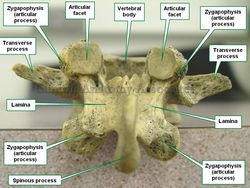|
The term [zygapophysis] is Greek. [-zyg-] means "yoked" or "paired", [-ap-] means "away" or "out", while the suffix [-(o)physis] means "growth". The term means "a paired outgrowth". Its plural form is "zygapophyses". The term zygapophysis is used to denote four bony outgrowths or processes found in the posterior aspect of most vertebrae, arising in the zone of junction of pedicle and lamina. The zygapophyses are paired (left and right) and then they are inferior and superior. They are also called "articular processes". Each zygapophysis presents with a smooth articular surface called an [articular facet]. Each articular facet is covered with hyaline cartilage. Two adjacent articular facets will form a synovial type joint known as a zygapophyseal joint or a facet joint. |
|
| In the cervical region the zygapophyseal joints are so close that they form a lateral pillar, known as the "lateral mass" or "articular pillar".
Arthritic degeneration of the zygapophyseal joints can lead to reduced spinal mobility and pain. The image shows the posterior view of a lumbar vertebra. Click on the image for a larger depiction. Image property of:CAA.Inc.Photographer:David M. Klein |
|
| Back to MTD Main Page | Subscribe to MTD |
